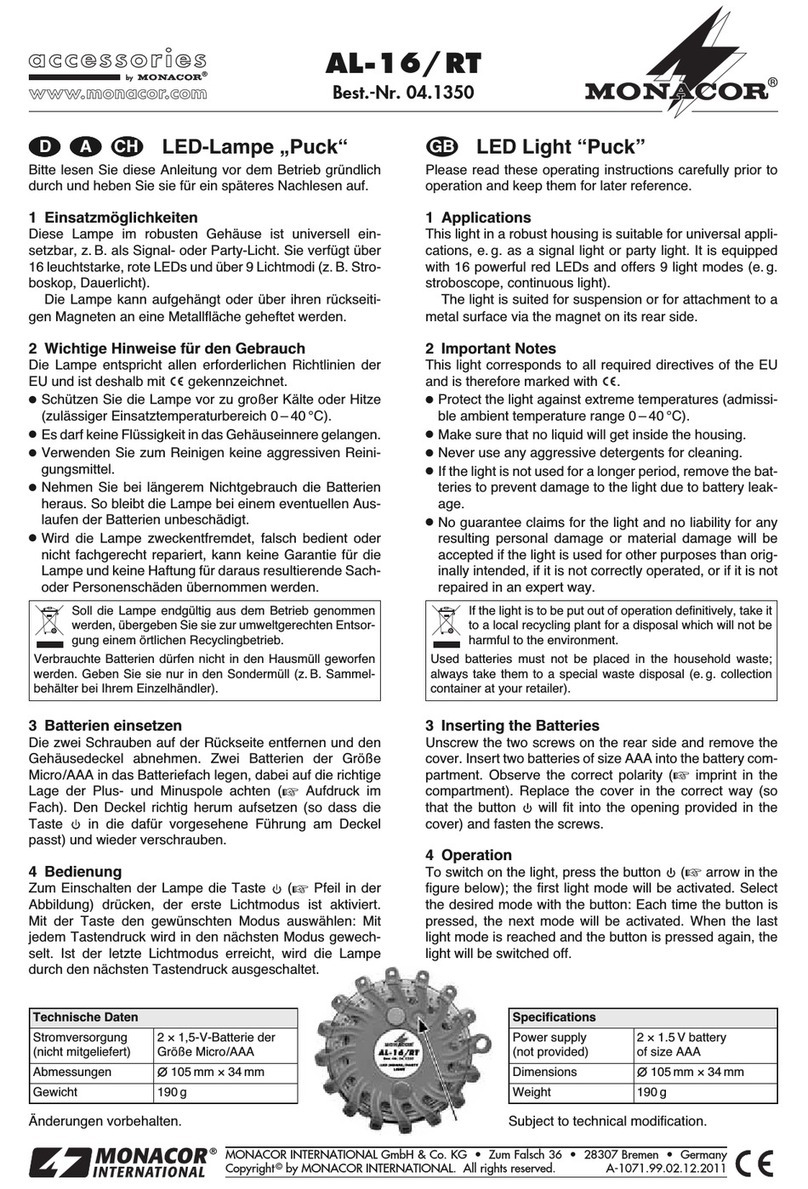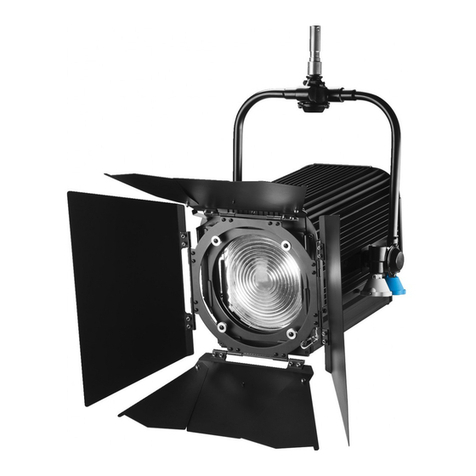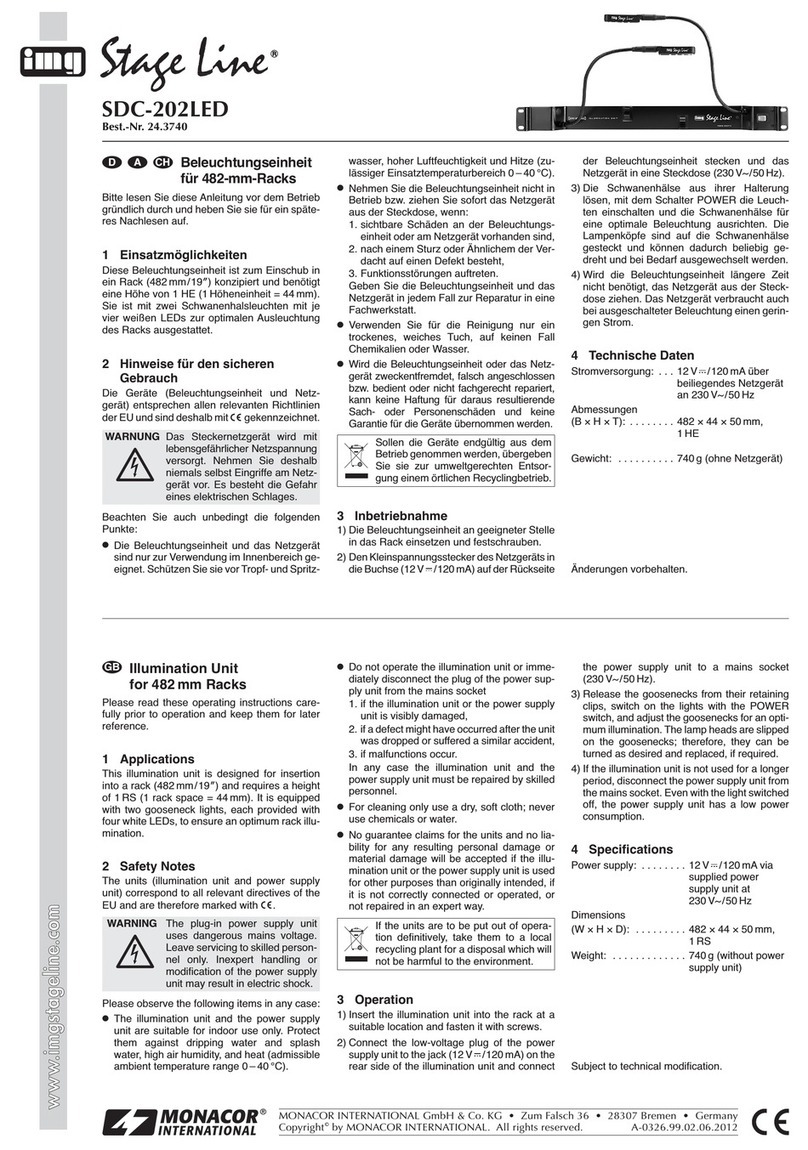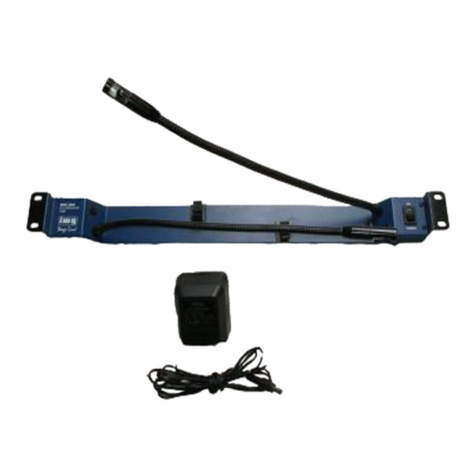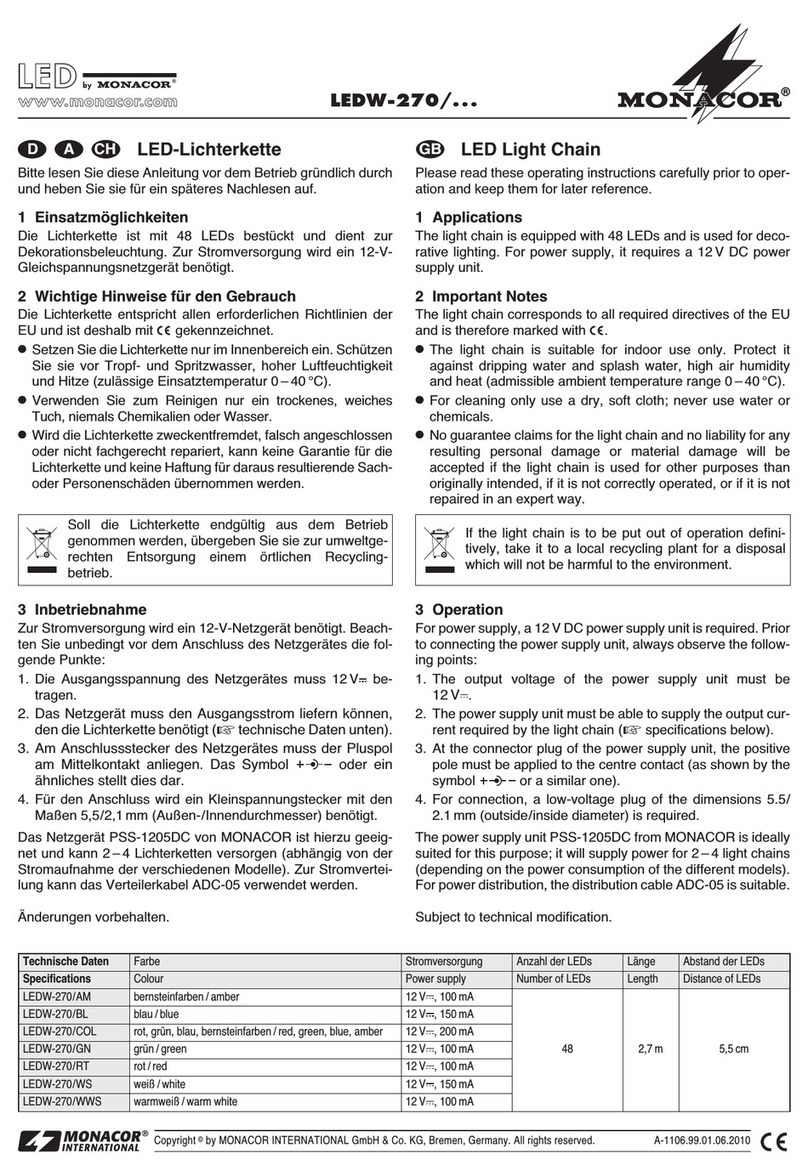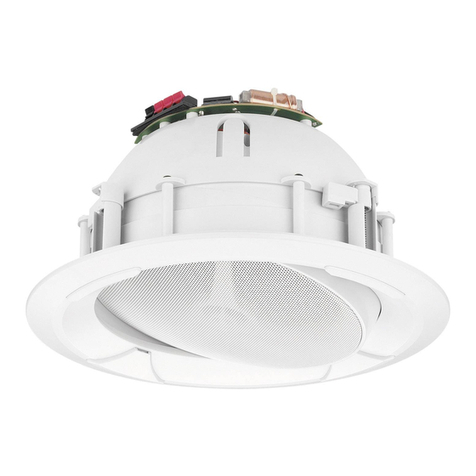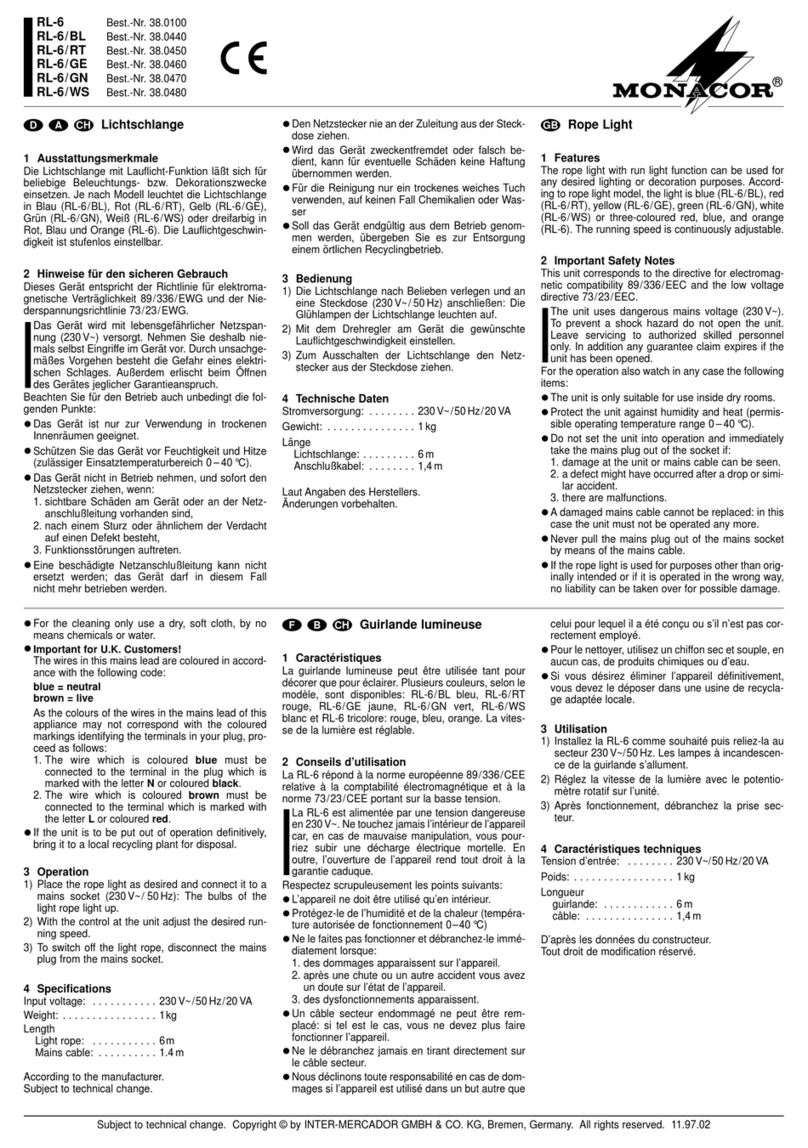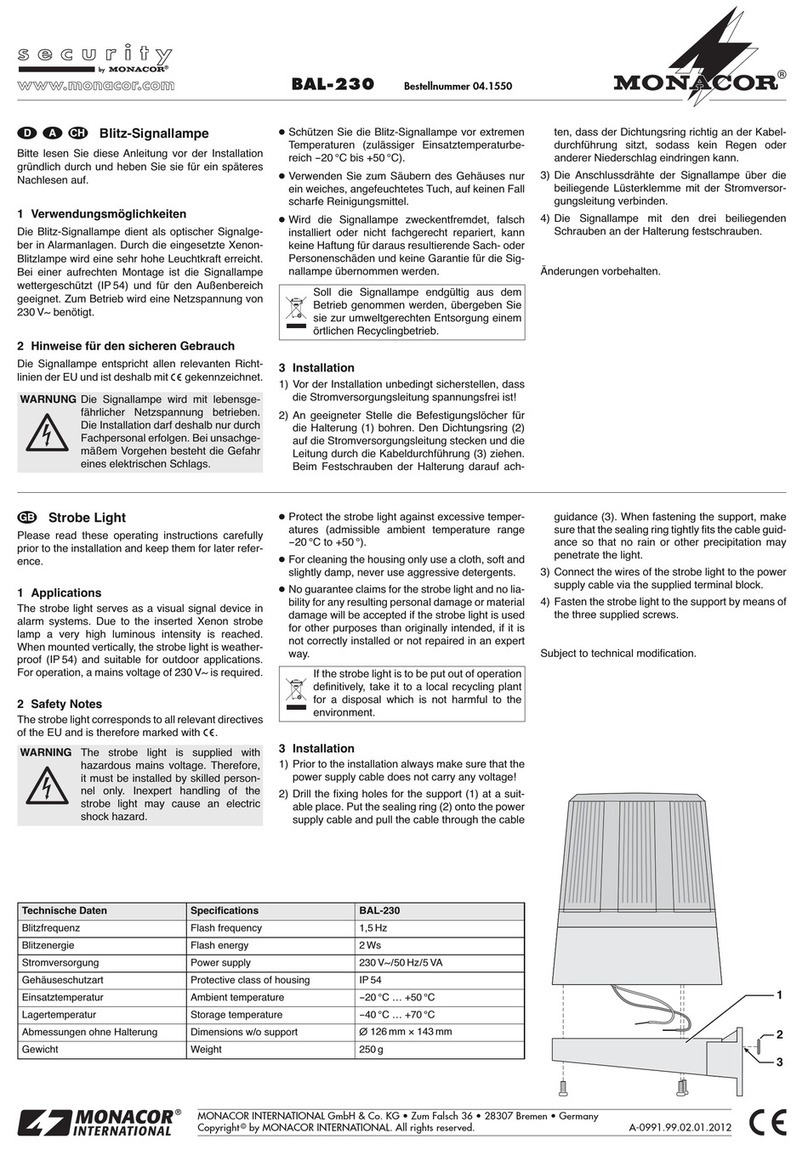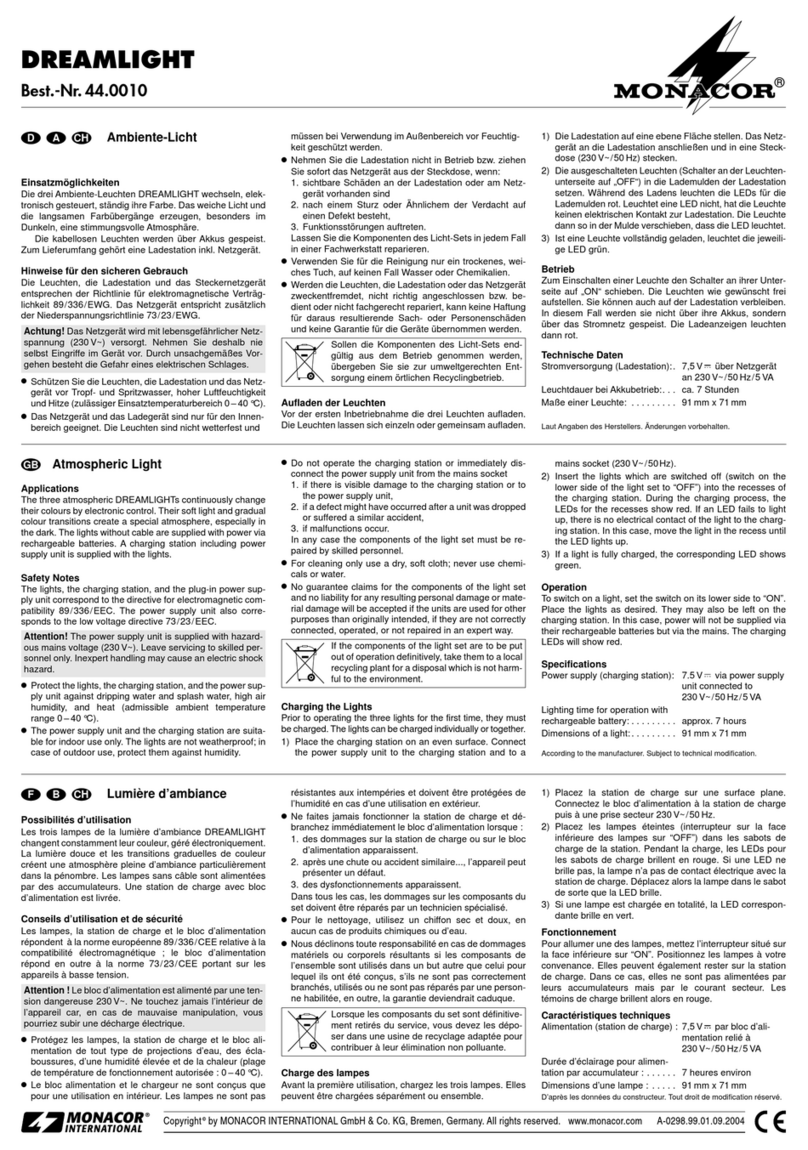
ELECTRONICS FOR SPECIALISTS ELECTRONICS FOR SPECIALISTS ELECTRONICS FOR SPECIALISTS ELECTRONICS FOR SPECIALISTS ELECTRONICS FOR SPECIALISTS ELECTRONICS
MONACOR INTERNATIONAL GmbH & Co. KG • Zum Falsch 36 • 28307 Bremen • Germany
Copyright©by MONACOR INTERNATIONAL. All rights reserved. A-0413.99.05.11.2017
Barrière lumineuse infrarouge
àréflexion
Cette notice s‘adresse à l‘installateur qualifié
de la barrière lumineuse. Veuillez lire la pré-
sente notice avec attention avant l’installation et
conservez-la pour pouvoir vous y reporter ulté-
rieurement.
1 Possibilités d’utilisation
La barrière lumineuse à réflexion permet de détecter
des personnes ou objets par exemple pour la surveil-
lance d’entrées de bâtiments, accès ou à des fins de
contrôle. Elle fonctionne avec une lumière infrarouge
avec une distance du réflecteur de 20cm à 14 m. En
cas d’interruption du rayon lumineux sur le chemin
allant de l’émetteur (10) au récepteur (9) via le réflec-
teur (1), un relais avec contact de commutation est
déclenché. Grâce au boîtier résistant aux intempéries
(IP66), la barrière est également adaptée pour des
installations en extérieur.
2 Conseils importants
La barrière répond à toutes les directives nécessaires
de l’Union Européenne et porte donc le symbole .
•
La barrière est protégée contre les intempéries mais
n’est pas complètement étanche. Ne la plongez ja-
mais dans l’eau.
•
Ne faites pas fonctionner la barrière dans des zones
soumises à des températures extrêmes (plage de
température de fonctionnement autorisée −20°C
à +55°C).
•
Pour le nettoyage, n’utilisez pas de produits
chimiques ou de détergents agressifs.
•
Nous déclinons toute responsabilité en cas de dom-
mages corporels ou matériels résultants si la bar-
rière est utilisée dans un but autre que celui pour
lequel elle a été conçue, si elle n’est pas correcte-
ment installée ou si elle n’est pas réparée par une
personne habilitée, de même, la garantie devien-
drait caduque.
Lorsque la barrière lumineuse est définitive-
ment retirée du service, vous devez la dépo-
ser dans une usine de recyclage adaptée pour
contribuer à son élimination non polluante.
3 Installation
Conseil pour le lieu de montage :
–Si plusieurs barrières sont utilisées, montez-les de
telle sorte qu’elles ne puissent pas interférer les
unes avec les autres.
–Pour des objets avec une surface réfléchissante, il
faudrait monter la barrière de telle sorte que les
objets passent à travers le rayon lumineux infra-
rouge dans un angle sinon ils pourraient ne pas
être détectés.
–Dans le cas d’une installation à l’air libre, le lieu de
montage doit être sélectionné de telle sorte que les
fausses alarmes (causées p.ex. par des plantes que
le vent fait bouger ou des animaux se déplaçant)
puissent être évitées autant que possible.
3.1 Montage et branchement
1) Pour le moment, installez provisoirement le réflec-
teur (1) avec une vis et l‘unité émetteur/récepteur
(5) avec son support de montage de telle sorte qu‘ils
se fassent face. Veillez à ce que la distance entre eux
soit de 20cm au moins et de 14 m au plus.
2) Reliez l’unité émetteur/récepteur à une tension
d’alimentation. La configuration des conducteurs
du câble de branchement (6) est décrite sur le
schéma. Comme alimentation, on peut utiliser
une tension alternative ou une tension continue
12–48V (la polarité lors du branchement à une
source de tension DC est insignifiante).
3) Reliez un appareil pour évaluer l’interruption du
rayon lumineux (par exemple émetteur de signal,
centrale d’alarme, compteur) aux contacts des re-
lais présentés sur le schéma. Veillez à ce que la
puissance maximale de contact de ⎓
30V/3A et
~
48V/3A ne soit pas dépassée.
3.2 Alignement de la barrière lumineuse
Pour indiquer l’état de fonctionnement, l’unité émet-
teur/récepteur est dotée de deux LEDs qui facilitent
l’alignement de la barrière. La LED jaune (7) brille si
la barrière est correctement alignée. La LED rouge
(8) brille si l’unité émetteur/récepteur et le réflecteur
ne sont pas correctement alignés l’un par rapport
à l’autre, si l’éloignement du réflecteur avec l’uni-
té émetteur/récepteur est trop grand ou si le rayon
lumineux est interrompu.
1) Ouvrez le couvercle (4).
2) Les ouvertures des potentiomètres trimmer sont
couvertes par une bande adhésive pour éviter que
l’humidité ne rentre dans l’ouverture. Retirez la
bande, protégez la couche adhésive des salissures
pour qu’elle puisse encore coller une fois le ré-
glage effectué.
3) Mettez le potentiomètre trimmer «Sensing
Range» (2) sur la butée de droite avec un petit
tournevis.
4) Alignez le réflecteur de telle sorte que la LED jaune
brille si le rayon lumineux n’est pas interrompu.
5) Si besoin, corrigez également l’alignement de
l’unité émetteur/récepteur.
6) Si la barrière est alignée de manière optimale, pro-
cédez au montage définitif.
3.3 Réglage de la sensibilité
Avec le potentiomètre trimmer «Sensing Range» (2),
on peut régler l’intensité avec laquelle la barrière doit
réagir en cas de coupure du rayon lumineux.
Si une faible puissance lumineuse (Min) est réglée,
la barrière peut déclencher même si de très petits
objets coupent le rayon lumineux. Si une puissance
lumineuse élevée (Max) est réglée, les petits objets
sont ignorés par la barrière.
1) Tournez le potentiomètre trimmer de la sensibilité
(2) sur la butée de gauche.
2) Si la LED jaune (7) ne brille pas encore, tournez
le potentiomètre trimmer lentement jusqu’à ce
qu’elle commence à briller.
3) Faites passer l’objet à détecter à travers le rayon
lumineux, à l’endroit où il va le traverser habituel-
lement. La LED rouge (8) devrait à cet instant-là,
briller à la place de la jaune.
4) Tournez lentement le potentiomètre trimmer dans
le sens des aiguilles d’une montre jusqu’à ce que
la LED jaune brille à nouveau. Pour des objets plus
grands, les LEDs ne changent plus jusqu’à ce que
la butée de droite soit atteinte.
5) Le réglage recommandé de la sensibilité, pour un
fonctionnement fiable, est la position médiane
entre les deux positions du potentiomètre déter-
minées aux points 2) et 4), où les LEDs changent
(ou à la butée correspondante s’il n’y a pas de
changement de LEDs).
6) Avec le potentiomètre trimmer «Response Time»
(3), on peut régler, dans la plage 5 –100 ms, la
durée pendant laquelle le faisceau lumineux doit
être interrompu pour que le relais se déclenche.
7) Une fois le réglage terminé, scellez les ouvertures
des potentiomètres avec la bande adhésive et fer-
mez le couvercle (4).
4 Caractéristiques techniques
Distance réflecteur : . . . . . .0,2–14m
Relais
Temps de réponse :. . . . .5 –100 ms réglable
Puissance contacts : . . . .
~
48V/3A
⎓
30V/3A
Température fonc. :. . . . . . .−20°C à +55°C
Tension alimentation :. . . . .12 – 48 V,
~
ou ⎓
Consommation :. . . . . . . . .65mA ±10%
Classe protection : . . . . . . .IP66
CARTONS ET EMBALLAGE
PAPIER À TRIER
20,5 mm
51 mm
39 mm
⌀ 82 mm
8,5 mm
29 mm
63 mm
ou
⎓12–48V
Relais
Alimentation
marron
noir
gris
blanc
bleu
n.o.
n.c.
~
12–48V
1
234
5
6
7
8
9
IRS-100
Référence numérique 04.2940
Français
Français
Tout droit de modification réservé.

